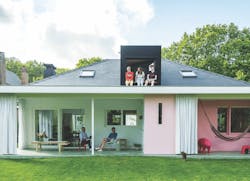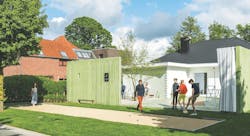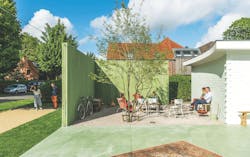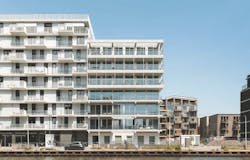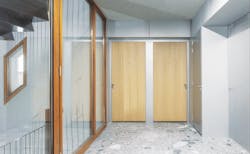The COVID-19 pandemic was a moment in human history that opened our eyes to how quickly events can influence lifestyles. It transformed how we work (remote or hybrid), where we want to live (urban, suburban, or exurban), and what are our expectations for the home’s “immune system” (a place of well-being and resilience). Now, post-pandemic, those expectations are taking form as fresh strategies that are reinventing home building for the new-home market.
It’s critical to look at the implications these shifts have for employment, construction, and housing design. In essence, our society is in a revised pioneering era where the future of home building is being reinvented due to a host of factors (climate, behavior patterns, worker and materials shortages) that redirect consumer and builder needs. And we are staying in our homes much longer than in the past, so a home has to be built for flexibility as lifestyle needs change.
At the same time, we have a massive new homeowner generation of more than 90 million Millennials that brings unconventional traction to the future of "home" as a private dwelling that has been commercialized by a multitude of activities—fitness, education, and play—beyond work.
Reinventing Home Building Starts Now
While it’s challenging to reimagine the past for a new future, it’s also an exciting time that presents previously undiscovered opportunities to attract a new type of workforce, build truly resilient homes, and reinvent floor plans to accommodate changing needs. Let's use this self-enforced wake-up call as inspiration for innovations we can use in reinventing home building to bring interesting solutions to these big issues, going beyond quick-fix solutions to provide longer-term strategies for success.
RELATED
- The Need for Resilient Construction Is Real. How Are Home Builders Responding?
- Living Now: America at Home Study Concept Home
- Home Design That Differentiates
Employment: Challenges and New Approaches
Attracting a new generation of construction workers is a key challenge for the home building industry, as an overwhelming number of construction workers are expected to retire over the next decade. According to the National Center for Construction Education and Research, 41% of the current construction workforce will retire by 2031. And the $1.2 trillion Infrastructure Investment and Jobs Act passed by Congress and signed into law on Nov. 15, 2021 is certainly to add to home building's labor issues as roads, bridges, and other infrastructure projects are built, updated, and upgraded nationwide, requiring additional labor.
Home builders face the challenge not only of attracting new employees, such as women and young adults, but also of retaining them.
Below are some tactics being applied in the U.S. and elsewhere.
Governments Get Involved
In Australia, the state of Western Australia is using AU$2.4 million (about $1.6 million USD) to promote skilled migration, as well as implementing a new AU$11 million ($7.1 million USD) Construction Visa Subsidy Program that will award up to AU$10,000 each to migrants in an effort to attract a target of 1,100 skilled migrants to the state’s building and construction sector.
Meanwhile, the U.K. has eased its immigration rules to address the construction labor shortage by adding bricklayers, carpenters, plasterers, and roofers, among other skilled trades, to its “shortage occupation” list. The policy shift is expected to provide a major boost to U.K. home builders looking to hire workers.
And in the U.S., the National Association of Home Builders (NAHB) is actively working with federal lawmakers on immigration policies that would enable more skilled construction workers from Mexico and elsewhere to enter the country legally and boost the workforce.
NAHB also awards scholarships and offers supporting skills-training programs through the Home Builders Institute and other partnerships, among several other efforts, to help alleviate the U.S. labor shortage.
Inspired Recruitment Methods
Innovative ways of attracting more youth and women to the workforce must go beyond generous salaries and offering health care benefits.
The housing industry needs new methods to engage at the high school level to promote construction as an alternative to college and position those jobs to reflect the values of younger generations, such as entrepreneurial opportunity, workplace flexibility, training and development, purpose and meaning, and innovative use of technology—all of which are true but not sufficiently communicated.
But while employers focus on attracting new employees, they need to also engage their current, mostly older, workforce with creative ways to retain them. Tech-enabled assistance, ways to reduce fatigue and risk of injury on the jobsite, opportunities to advance or improve skills, and their value as mentors to new workers should all be considered in recruitment and retention efforts.
Construction: Growing Climate Awareness and Innovative Responses
Building the Resilient Home
Recent mobility patterns in the U.S. have resulted in increased migration to the Sun Belt, with implications for home design in the form of fewer basements and the need for more climate-related innovation.
And growing awareness of “resilient” construction is shaping housing, too. Single-level versus multistory homes, more indoor/outdoor opportunities, sustainability implications including exterior shading and on-site energy; and design implications ranging from outdoor living and accessory dwelling units to floor plans that enable adaptability are all examples of ways we're reinventing home building today.
“Smood” (an acronym for “smart neighborhood”), a sustainable, energy-efficient, and affordable neighborhood redevelopment concept pioneered by the Fraunhofer Institute in Germany, is another example. The aim with Smood is to establish a holistic system to increase energy efficiency in an existing district using mainly local (in this case geothermal and solar) renewable energy sources. The project is a collaboration involving 16 companies, four research institutions, and a trade association, with scientific support from Fraunhofer.
Covering everything from digitalized planning processes and innovative district storage systems for electricity and heat to intelligent control and operational management solutions, Smood aims to ensure that existing utilities are ready for the energy transition and that occupants benefit from a lower cost of living as a result.
Emerging Construction Methods
The U.S. also suffers from a dramatic shortage of new housing, particularly affordable housing, to meet coming demand from Millennials and Gen Zers of homebuying age, and likely the generation after that.
It’s becoming increasingly clear that industrialized housing—namely modular homes—can offer a solution to both the industry’s housing supply and skilled labor shortages.
Not only does factory production target a different pool of workers with different skill sets for precision manufacturing, those skills are relatively easy to learn on the job with in-house training.
With that, efficient assembly-line processes require fewer workers to build the same number of homes, boosting overall productivity and, ultimately, the capacity to produce more than what can reasonably be expected from on-site, stick-built construction methods.
Living in a Future of Shortages
My firm constantly monitors global product and technology innovations that address a not-so-distant era where water and energy are expensive and limited.
As one example, engineers in Germany have developed an ultra-thin coating that can make solar panels and other surfaces self-cleaning, which dramatically improves the long-term efficacy and efficiency of solar products.
In the U.K., startup A&B Smart Materials has a novel smart hydrogel material that passively cools any surface to which it’s applied. The material is painted on the back of solar panels to increase efficiency, while the hydrogel absorbs atmospheric water at night and releases it through evaporation during the day to cool the solar panel.
Reinventing Housing Design: New Ways of Living
Neighborhood Revival
In Bruges, Belgium, the G-Lab house (see photos, above) is an experiment in neighborhood connectivity that is reinventing home building within a traditional suburban setting. While the home is designed to be a private family space when needed, it also can be shared by the community, with a series of spaces that play with different levels of privacy by opening up to invite neighborly engagement.
Another example is The Doors (see photos, below), a multifamily live-work housing complex in Amsterdam designed by Dutch architecture firm Space Encounters. Each apartment has two front doors, enabling residents to set up a business adjacent to their dwelling unit and, in the future, possibly shift use of that work space to be an independent living arrangement for an adult child or an elderly parent.
The pandemic won’t be the last major interruption to our norms, and societal changes are likely to occur more often in our increasingly connected world. And we have to accommodate multiple homeowner generations, each with its own unique needs and expectations. So you’ll see innovation around the needs of each generation, such as aging Boomers’ future needs (aka the Health Care Home), Gen X’s increasing adaptation to the multigenerational home, Millennials’ reinvention in the creative/smart home, and, for our newest adult generation, Gen Z, a move in the direction of the self-sufficient home.
Change is good. It wakes us up to the stuff we haven’t been paying attention to and shines a beacon toward what can be a new renaissance. It’s never too soon to learn and prepare for a future that will be very different from what we’ve known in the past.
Susan Yashinsky is VP of innovation at Sphere Trending, which advises a variety of industries on future pathways for relevant products, marketing, technology, and design based on societal understanding and forecasting.

